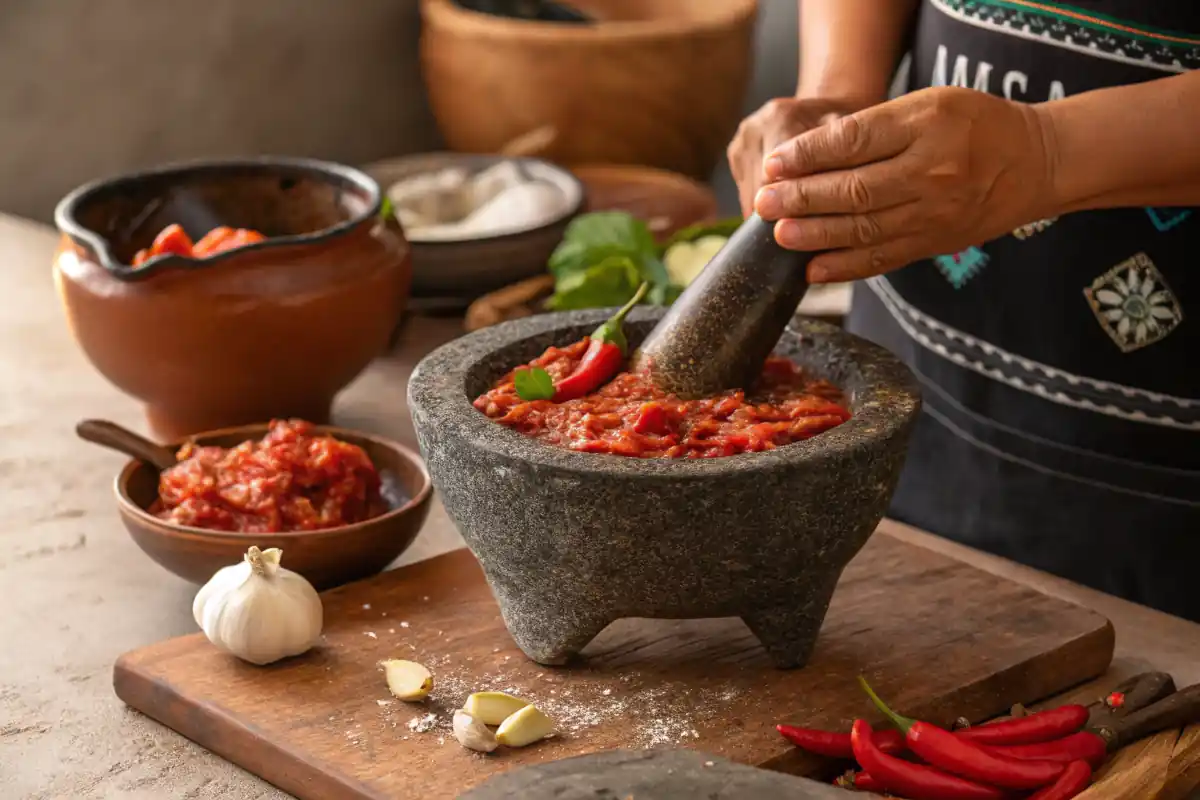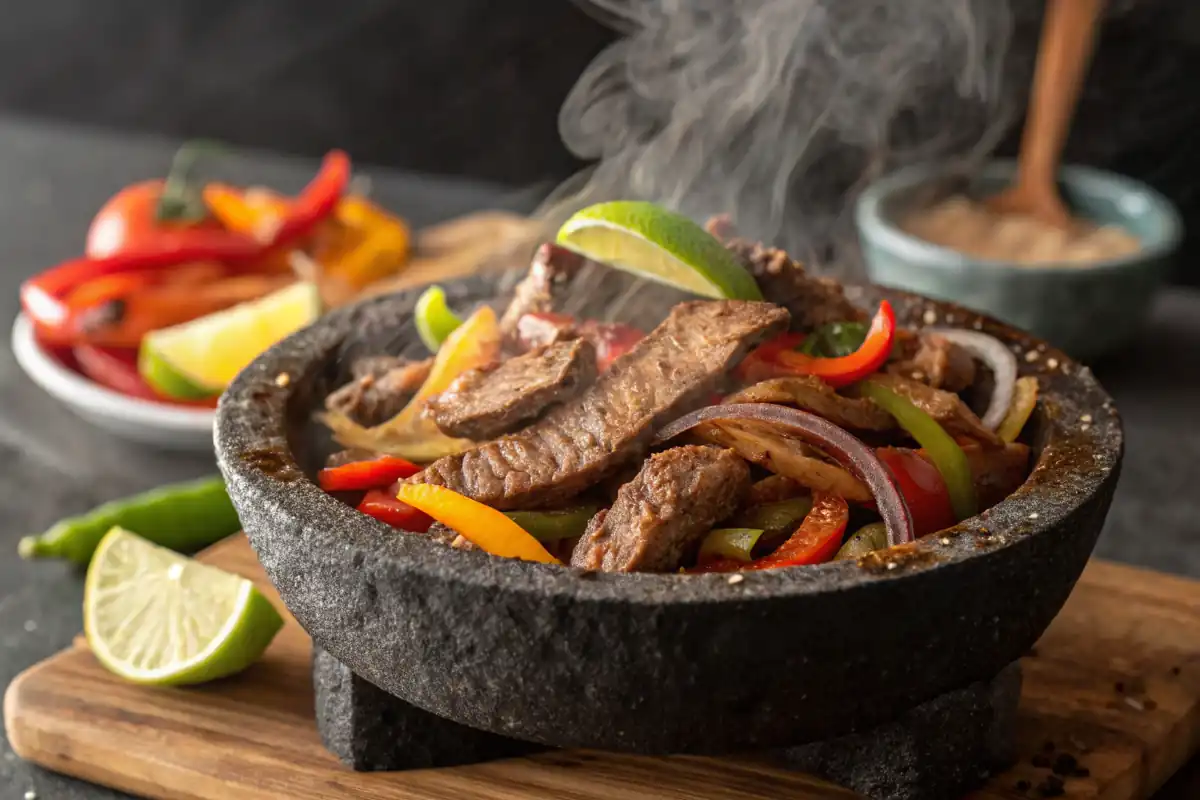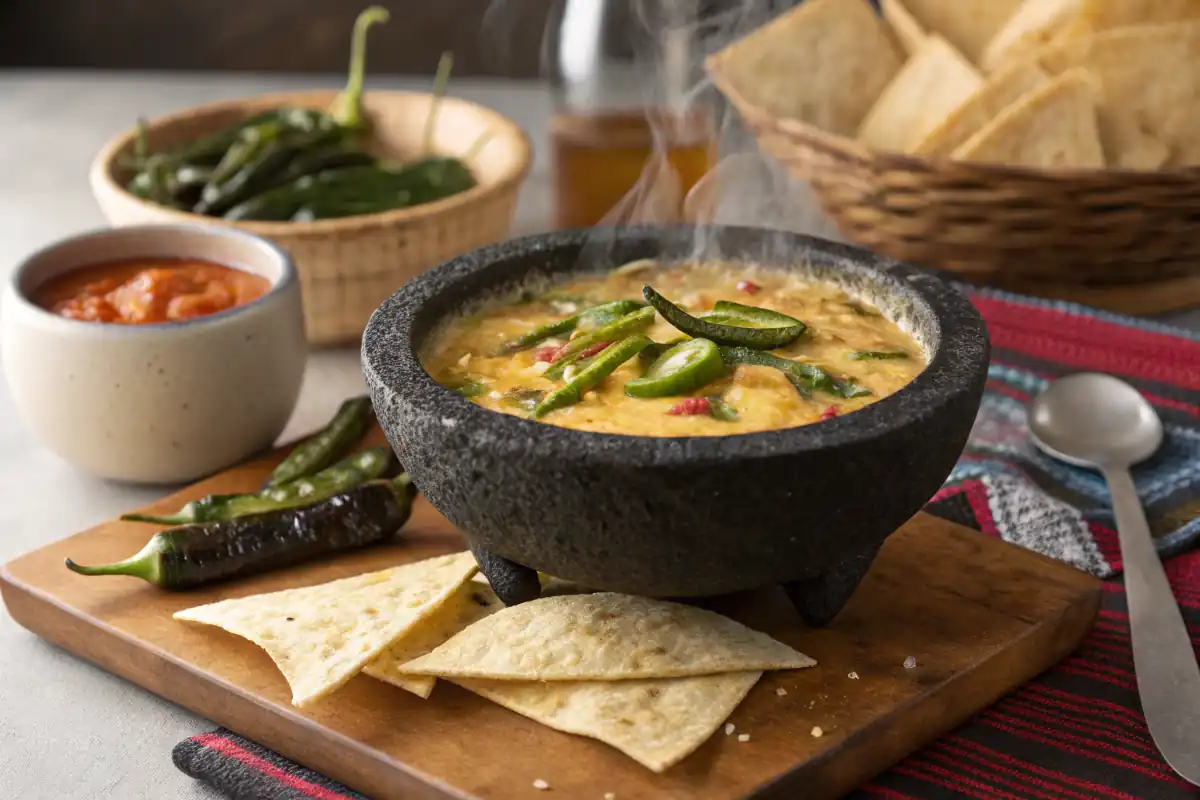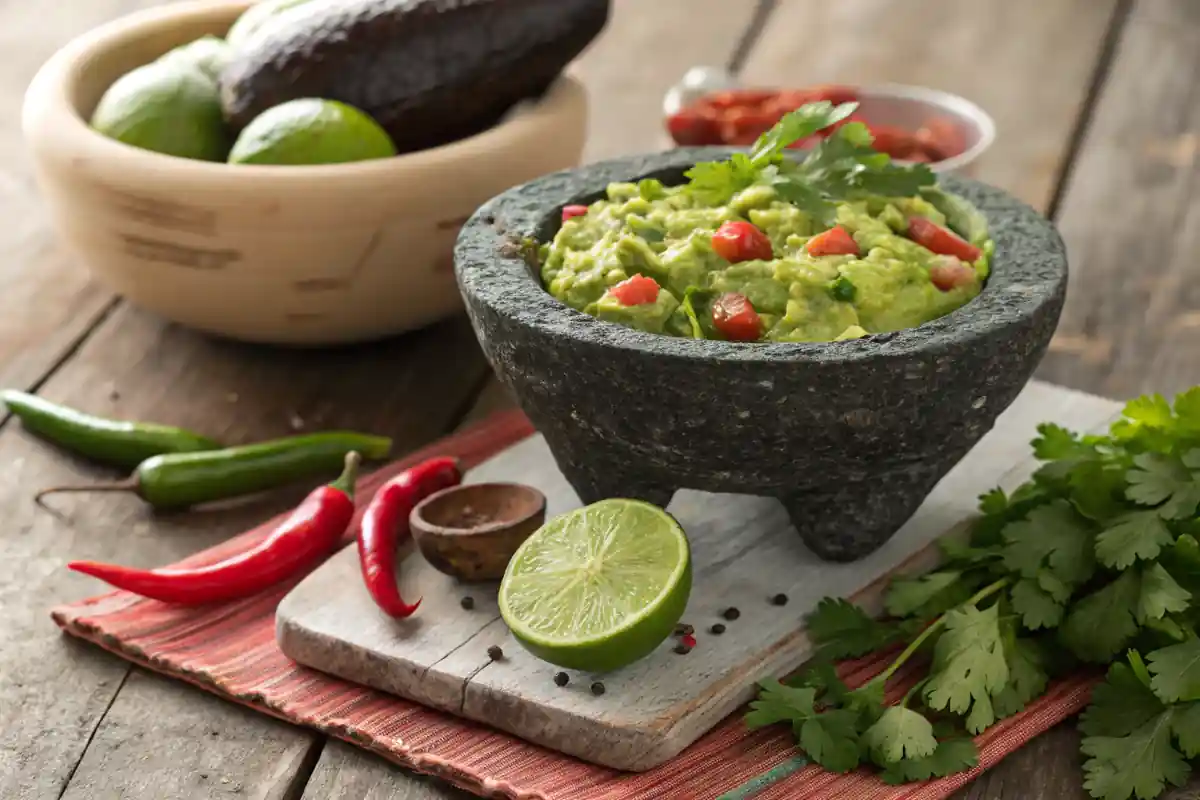A molcajete isn’t just a kitchen tool—it’s a culinary tradition steeped in history and flavor. From crafting rich, smoky salsas to preparing hearty, vibrant dishes, this iconic Mexican mortar and pestle unlocks tastes that a blender simply can’t replicate. But, you might be wondering, what do you put in a molcajete? Well, that’s exactly what we’ll uncover in this guide. We’ll explore everything from essential ingredients to expert techniques, and even dive into the art of serving food in this timeless stone vessel. Let’s get started!
What is a Molcajete?
Origins and History of the Molcajete
The molcajete dates back thousands of years, originating in Mesoamerica, where early civilizations like the Aztecs and Mayans used it to grind spices, seeds, and grains. Crafted from volcanic rock, this tool symbolizes Mexican heritage and has been passed down through generations. Unlike modern kitchen gadgets, the molcajete relies on elbow grease to bring out the aromas and flavors locked in ingredients.
The Anatomy of a Traditional Molcajete
A traditional molcajete consists of two parts: the mortar (the bowl) and the pestle (called a tejolote). The rough surface of volcanic stone makes it perfect for grinding and blending. The slightly concave bowl prevents ingredients from spilling, while the hefty pestle allows for efficient crushing. This combination ensures flavors meld together seamlessly.
Cultural Significance in Mexican Cuisine
The molcajete isn’t just a cooking tool; it’s a symbol of community and tradition. In Mexican households, it’s common to see a molcajete used during family gatherings, preparing beloved staples like guacamole or salsa. Recipes prepared in a molcajete often carry a deeper connection, as they’re crafted with care and patience—qualities that define Mexican cuisine.
How to Use a Molcajete Properly
Seasoning Your Molcajete Before Use
If you’ve just purchased a molcajete, seasoning it is a crucial first step. Unseasoned molcajetes can leave a gritty residue in your food. To prep it, rinse it thoroughly with water (no soap!) and grind uncooked rice in batches until the rice remains white. This removes any loose volcanic stone particles. Once seasoned, your molcajete is ready to enhance the flavors of your dishes.
Basic Techniques for Grinding Ingredients
Using a molcajete may seem intimidating at first, but it’s surprisingly simple. Place your ingredients, such as garlic, chilies, or herbs, in the bowl. Using the tejolote (pestle), press and grind in a circular motion. The rough volcanic surface breaks down ingredients while releasing their aromas and essential oils. Unlike a blender, a molcajete allows you to control the texture, making it ideal for chunky salsas or creamy guacamole.
Tips for Cleaning and Maintaining Your Molcajete
Cleaning a molcajete is just as important as using it. After each use, rinse it with warm water and scrub gently with a brush. Avoid soap, as it can seep into the stone and alter the flavor of your food. Once clean, let it air dry completely to prevent mildew. With proper care, your molcajete can last for decades, becoming a cherished kitchen heirloom.
Want a recipe to try in your molcajete? Check out this guacamole recipe.
Essential Ingredients for Your Molcajete
Traditional Ingredients for Authentic Mexican Recipes
When asking, What do you put in a molcajete?, the answer often starts with traditional Mexican staples. Ingredients like roasted tomatoes, garlic, onions, and chilies form the base for salsas. Meanwhile, ripe avocados, lime juice, and cilantro are essential for authentic guacamole. These ingredients, when crushed in a molcajete, produce richer, more nuanced flavors than their blender-made counterparts.
Spices and Herbs Commonly Used
To elevate your dishes, grind dried spices like cumin seeds, black peppercorns, or coriander in your molcajete. Fresh herbs like basil, oregano, or thyme can also be ground to release their oils, infusing your dishes with bold, vibrant flavors. This method works wonderfully for dry rubs or marinades.
Alternative Ingredients for Fusion Dishes
While a molcajete is traditionally used for Mexican cuisine, it’s also great for preparing ingredients for fusion dishes. Try grinding ginger and garlic for Asian-inspired stir-fries or creating pesto with fresh basil and pine nuts for Italian meals. The versatility of a molcajete makes it an invaluable tool in any kitchen.
Popular Recipes Made in a Molcajete
Classic Salsas: Roja, Verde, and Pico de Gallo

One of the best answers to the question What do you put in a molcajete? is salsa! A molcajete brings out the vibrant, smoky flavors of fresh ingredients, especially in salsas like salsa roja, salsa verde, and pico de gallo. To make salsa roja, char tomatoes, chilies, garlic, and onions before grinding them into a rich paste. For salsa verde, tomatillos, serrano peppers, and cilantro are crushed until perfectly blended. And don’t forget pico de gallo—diced tomatoes, onions, cilantro, lime juice, and salt meld beautifully in a molcajete, creating a chunky, fresh topping for tacos or chips.
Guacamole and Its Variations
No molcajete guide would be complete without guacamole! Mashing ripe avocados with lime juice, chopped onions, garlic, and fresh cilantro in the stone bowl creates a creamy yet textured dip. For variety, try adding roasted corn, diced mango, or even crumbled queso fresco. The porous texture of the molcajete mixes everything evenly while enhancing the avocado’s natural creaminess.
For another creative guacamole recipe, check out this 4-ingredient guacamole.
Molcajete Fajitas and Meat-Based Dishes

Molcajetes aren’t just for dips—they’re also fantastic for serving sizzling fajitas or hearty meat-based dishes. Many Mexican restaurants use a heated molcajete to serve beef, chicken, or shrimp with vegetables and sauce. The stone keeps the dish hot while infusing it with a rustic, smoky flavor.
Vegetarian Options and Side Dishes
For vegetarians, a molcajete is perfect for preparing roasted vegetable blends, black bean dips, or hearty salads. You can even use it to make traditional sides like refried beans, ensuring a smooth, rich texture that tastes homemade.
The Art of Presentation: Serving Food in a Molcajete
Tips for Preparing a Molcajete for Serving
A warm molcajete elevates any dish, giving it an authentic, rustic charm. To prepare your molcajete for serving, heat it in an oven or over a flame. A hot bowl keeps your food warm longer and enhances the overall dining experience. Be sure to handle it carefully—it retains heat exceptionally well.
Why Molcajetes Enhance Flavor and Texture
The porous surface of a molcajete isn’t just for grinding—it also releases a hint of volcanic minerals into the food, adding depth to its flavor. The texture it creates, whether for salsas, guacamole, or rubs, is unparalleled. Plus, serving directly in the molcajete keeps ingredients at their best consistency for longer.
Creative Ways to Serve Dishes Using a Molcajete

Beyond traditional Mexican dishes, you can use a molcajete to present dishes with flair. Serve bubbling queso fundido, chilled ceviche, or even a creative dessert like fruit salad with a hint of lime and chili powder. The rustic look of the molcajete makes any dish feel special and memorable.
Frequently Asked Questions About Molcajetes
Can I Use a Molcajete for Non-Mexican Recipes?
Absolutely! While molcajetes are a staple in Mexican cooking, they’re incredibly versatile. Beyond salsas and guacamole, you can use them to make pesto, hummus, or even spice blends. Grinding fresh ginger and garlic for stir-fries or preparing Indian chutneys works wonderfully in a molcajete. So, if you’re wondering, what do you put in a molcajete outside traditional dishes, the answer is almost limitless.
How Do I Prevent My Ingredients From Sticking?
If ingredients stick to the surface, don’t worry—it’s normal for unseasoned or dry molcajetes. To fix this, season the bowl properly by grinding uncooked rice until it remains white. Additionally, adding a touch of water, oil, or lime juice while grinding can help create smoother mixtures. Maintaining the right moisture balance ensures optimal texture without sticking.
What Is the Best Material for a Molcajete?
Traditional molcajetes are made from volcanic basalt, which offers the perfect rough texture for grinding and is incredibly durable. Avoid synthetic or overly polished alternatives, as they may not provide the same flavor-enhancing qualities. Investing in an authentic volcanic stone molcajete ensures the best results for your culinary creations.
How Do I Restore a Damaged Molcajete?
If your molcajete starts to lose its surface texture or develops cracks, you can revive it. Use coarse sandpaper to smooth out any rough spots and re-season it by grinding rice and salt. For severe cracks, a replacement might be necessary to avoid contamination or uneven grinding.
Final Thoughts on What You Put in a Molcajete
A molcajete is more than just a kitchen tool—it’s a doorway to bold, unforgettable flavors. From crafting classic salsas to exploring fusion cuisines, this versatile mortar and pestle opens up endless possibilities. Whether you’re preparing guacamole, grinding spices, or serving fajitas, it enhances texture and taste in ways modern appliances can’t replicate.
Its cultural roots make it a meaningful addition to any kitchen. By learning how to use a molcajete effectively, you not only embrace traditional cooking but also elevate everyday meals. Pair it with fresh, high-quality ingredients to create authentic dishes that leave a lasting impression.
So, next time you’re in the kitchen, ditch the blender and reach for your molcajete. You’ll find that the time-honored art of grinding ingredients by hand brings new depth to your cooking. For more inspiration, explore a variety of molcajete recipes and start experimenting today!

